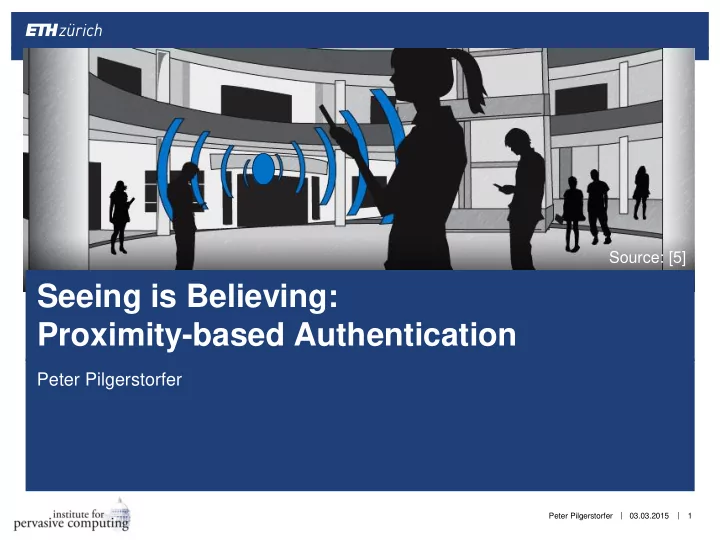

Source: [5] Seeing is Believing: Proximity-based Authentication Peter Pilgerstorfer | | Peter Pilgerstorfer 03.03.2015 1
Motivation Pairing without user interaction Traditional authentication E.g. enter/confirm shared PIN Not possible for certain IoT devices Not scalable Use cases NFC payments Keyless entry and start systems Secure pairing for implants … 2
Goal A secure and authentic connection between two devices Shared secret Verify authenticity Assumption: Authentic if the devices are within proximity to each other Why does proximity lead to trust? How to determine proximity? 3
Why does proximity lead to trust? Image sources: [9-11] 4
How to determine proximity? Time of Flight Radio signal RSSI (Received Signal Strength Indicator) Accelerometer Illumination Audio signals … 5
Overview Wi-Fi Time of Flight, CoNext 2014 Amigo, UbiComp 2007 ProxiMate, MobiSys 2011 Image sources: [6-8] 6
Wi-Fi Time of Flight Measure response time t f = 1 2 𝑢 𝑛 − 𝑢 𝐵𝐷𝐿 − 𝜀 Calculate the distance 𝑒 = 𝑑 ⋅ 𝑢 𝑔 𝑢 𝑔 𝑢 𝐵𝐷𝐿 𝑢 𝑔 𝜀 𝑢 𝑛 send receive Alice Data ACK d Bob receive send Time 7
Wi-Fi Time of Flight - Challenges Noisy measurements Multiple paths Imprecise hardware Consequences Measure multiple times Effective median error: 1.7 – 2.4𝑛 Image taken from Marcaletti et al [1] LOS: line-of-sight NLOS: non-line-of-sight 8
Wi-Fi Time of Flight - Challenges Processing time Keep 𝜀 as low as possible What if attacker is faster? with 𝜀 = 10.2 𝜈𝑡, up to ~1500 𝑛 “closer” 𝜀 𝐶𝑝𝑐 receive send Alice 𝑒 𝐶𝑝𝑐 Data ACK Bob 𝑒 𝐹𝑤𝑓 Eve send receive Time 𝜀 𝐹𝑤𝑓 9
Wi-Fi Time of Flight - Conclusion + Works with standard Wi-Fi hardware Assumes that attacker doesn’t have access to faster hardware Not suitable for close distance pairing Many packets have to be sent 10
Wi-Fi Time of Flight - Improvement Use special hardware to reduce processing time With 𝜀 𝑈 < 1𝑜𝑡 an attacker can appear at most ~15 𝑑𝑛 closer Reflect “instantly” Avoid demodulating signal Suitable for IoT devices 𝑢 𝑛 send receive Alice Data Data d Bob reflect Time 𝜀 < 1𝑜𝑡 11
Amigo Radio environment is similar for devices in proximity Strategy: Passively observe received signal strength indicator (RSSI) for Wi-Fi packets Images taken from Varshavsky et al [3] 12
Amigo – Observation Wi-Fi cards are set to promiscuous mode Receive all packets Signature of the radio environment Hash of every observed packet RSSI of every observed packet RSSI Defined in IEEE 802.11 Received power level 13
Amigo – Authentication Establish shared secret Observe packets transmitted via Wi-Fi Send signature to each other (hash and RSSI) Check if the other device made similar observations 14
Amigo – Results Attackers >=3m away can be detected within 5s Improve security by hand waving Detect attackers within 1m 15
Amigo – Conclusion + Works with standard Wi-Fi hardware + Works reasonably well in close distances Paring time depends on Wi-Fi activity Diffie-Hellman key exchange is computationally intensive 16
ProxiMate Radio environment is similar for devices in proximity Strategy: Observe FM or TV radio signals directly instead of the received signal strength indicator Images taken from Mathur et al [4] 17
ProxiMate – Wireless Channel Wireless channel State described by complex number Amplitude given by absolute value Phase given by angle Features observed by ProxiMate: Amplitude Change of phase Use software-defined radio for measurements Image source: [13] 18
ProxiMate – FM/TV signal Frequency modulated Amplitude constant Amplitude variation not signal dependent TV: ~600 MHz FM: ~100 MHz Image source: [12] 19
ProxiMate – Authentication Basic idea: generate a key out of the observed radio environment Alice and Bob observe the environment Alice collects timestamps of observed extrema ( 𝑀 ) Alice sends timestamps to Bob Bob collects observed extrema at timestamps 𝑀 Extremas encode the key: Maximum … 1 Minimum … 0 20
ProxiMate – Bit-rate Bit-rate limited Wait long enough between two bits such that they are not correlated Bit errors occur and have to be corrected Reduced effective bit-rate Improve Bit-rate Use multiple radio stations simultaneously 21
ProxiMate – Results Pairing using 10 TV sources: 3.3s at 2.4 cm distance Pairing using 10 FM sources: 15s at 16.5 cm distance TV: ~600 MHz, ~50 cm wavelength FM: ~100 MHz, ~3 m wavelength 22
ProxiMate – Conclusion + Works reasonably fast in close distances + Pairing distance can be varied (using different radio channels) + Computationally lightweight Not yet applicable to todays devices 23
Conclusion Wi-Fi Time of Flight (by Capkun et al.) + Potentially fastest - Requires special-purpose hardware Amigo + Can be implemented with standard Wi-Fi hardware Requires Wi-Fi communication ProxiMate + Computationally cheap Requires more advanced radio interface 24
References [1] MARCALETTI, Andreas, et al. Filtering Noisy 802.11 Time-of-Flight Ranging Measurements. In: Proceedings of the 10th ACM International Conference on emerging Networking Experiments and Technologies . ACM, 2014. S. 13-20. [2] RASMUSSEN, Kasper Bonne; CAPKUN, Srdjan. Realization of RF Distance Bounding. In: USENIX Security Symposium . 2010. S. 389-402. [3] VARSHAVSKY, Alex, et al. Amigo: Proximity-based authentication of mobile devices . Springer Berlin Heidelberg, 2007. [4] MATHUR, Suhas, et al. Proximate: proximity-based secure pairing using ambient wireless signals. In: Proceedings of the 9 th international conference on Mobile systems, applications, and services . ACM, 2011. S. 211-224. Thank You 25
References [5] http://crowdweaver.co.uk/2012/02/11/proximity-marketing-what-is-it/ [6] http://photo.elsoar.com/alarm-clocks-and-stopwatch-hot-colorful-images.html [7] http://www.newgadget.org/mobile-phones/how-to-improve-your-phone-signal/ [8] http://www.naturapark.com.br/site/index.php/administradora/antcoletiva [9] https://ibtx.wordpress.com/2015/01/06/wearables-time/ [10] http://www.connected-home.de/ratgeber/geraete-ins-heimnetz-einbinden- 1472570.html [11] http://how2mediate.com/2010/12/01/is-mediation-a-waste-of-time-2/ [12] http://www.hill2dot0.com/wiki/index.php?title=Frequency_modulation [13] http://idmc.info/counter/22/amplitude-and-phase-spectrum-of-sine-wave 26
Recommend
More recommend